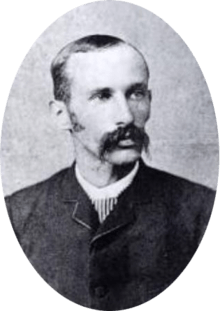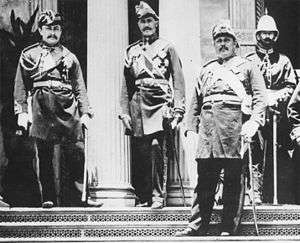Edward William Purvis
| Edward William Purvis | |
|---|---|
 | |
| Born | July 4, 1857 |
| Died |
August 16, 1888 (aged 31) Colorado Springs, Colorado |
| Buried at | Evergreen Cemetery |
| Allegiance |
United Kingdom Kingdom of Hawaii |
| Service/branch |
70th (Surrey) Regiment 31st (Huntingdonshire) Regiment King's Staff (Hawaii) |
| Rank | Colonel, Major, Sub-Lieutenant |
Colonel Edward William Purvis (July 4, 1857 – August 16, 1888) was a British army officer and settler of the Kingdom of Hawaii who served as Vice-Chamberlain during the reign of King Kalākaua. After resigning from the royal household, Purvis published two political satires aimed at undermining the image of the king and his Prime Minister Walter M. Gibson who had been responsible for the removal of Purvis' superior. These actions and other factors led to the demise of the Gibson regime and the Bayonet Constitution of 1887. He died in the following year, after going to the United States to seek medical attention for his health. According to popular legend, Purvis was an expert player of the Portuguese machete or cavaquinho and was believed to be the inspiration for the name of the Hawaiian ukulele.
Early life
He was born on July 4, 1857. Of British and Scottish descent, his parents were Robert Raaf Purvis and Annie Silburn Marshall. His grandfather William Purvis, who worked as a trader and ship captain, had settled in the Dutch East Indies in the 1810s while it was still part of the British Empire. The family lived in the Dutch East Indies, Brussels and London. Educated at Cheltenham College and Royal Military College, Sandhurst, he served as a sub-lieutenant of the 70th (Surrey) Regiment of Foot in Bengal where he learned the Hindi language and later as a sub-lieutenant for the 31st (Huntingdonshire) Regiment of Foot in Chatham, Kent. Around 1879, he resigned his British army post and traveled to the Hawaiian Islands, where his father and older brother Robert William Theodore Purvis had already settled on December 13, 1877; his brother Theodore had started a sugar plantation business on the island of Kauai.[1][2] A distant cousin of theirs was William Herbert Purvis known for introducing macadamia nuts to Hawaii.[3]
Career in Hawaii

Around 1879, Purvis settled in Honolulu. He later served as King Kalākaua's Vice-Chamberlain under Chamberlain Charles Hastings Judd. In 1882, he served as acting chamberlain during Judd's trip to Europe and was appointed as a member of the King's Staff with the rank of colonel on December 23, 1884. By the end of August 1886, he had resigned this office of vice chamberlain after his superior Judd was dismissed from his post and asked to resign by the king at the instigation of the newly appointed Prime Minister Walter M. Gibson and the cabinet ministers.[4][5][6]
Between 1886 and 1887, Purvis attempted to undermine the Gibson regime. He was alleged to be the author or co-author, along with Alatau T. Atkinson, of The Grand Duke of Gynbergdrinkenstein and the Gynberg Ballad, two anonymous political satires which parodied the corruption of the Hawaiian court and mocked Kalākaua, Gibson, and other people in their inner circle. According to Ralph Simpson Kuykendall these were "a satirical take-off on various features and incidents of the Kalakaua-Gibson regime" used "to convince the public that the administration of the kingdom was not only corrupt and unworthy of trust, but also ridiculous". At the annoyance of the government, these two pamphlets were widely circulated in Honolulu and even sent to London by the British ambassador to Hawaii.[5] These works and other factors contributed to the demise of the Gibson regime and the Bayonet Constitution of 1887 which severely limited the power of the king.[7]
Purvis made many friends amongst Hawaii's Portuguese immigrant community and became an expert player of the machete (otherwise known as the cavaquinho). And thus according to popular legend, it is popularly believed that the Hawaiian musical instrument, the ukulele (an adaption of these Portuguese instruments), was named for Purvis, as the term can be translated as "jumping flea", a nickname of the small, excitable and quick fingered Purvis.[4] Modern scholarship has cast doubt on this popular legend, though. According to historians John King and Jim Tranquada: "[i]t is unlikely that the nickname of a man who sought to undermine the king in the months prior to the imposition of the Bayonet Constitution of 1887 would have been applied to an instrument favored by native Hawaiians".[7]
Later life and death
After 1886, he became a resident of Hanamaulu, on the island of Kauai. In May 1888, he left the Hawaiian Islands for the United States for his health. Settling in Colorado Springs, Colorado, he initially wrote home stating that he was improving, but his condition worsened. His brother Theodore traveled all the way from Hawaii to see him for the last time before he died on August 16, 1888. He was 31 years old at the time of his death.[8] His brother-in-law Edmund William Holdsworth chosen as administrator of his estate; Purvis' will written in April 22 left everything to his brother Theodore Purvis.[9] His remains were interred in the Evergreen Cemetery in Colorado Springs.[10]
Honors
 Royal Order of Kapiolani, Commander, 1884[11]
Royal Order of Kapiolani, Commander, 1884[11]
References
- ↑ Siddall 1921, p. 323; Fordyce 1861, pp. 404–415
- ↑ Hunter 1890, p. 280; Hart 1877, pp. 83; Hart 1879, pp. 216; Great Britain. Ministry of Defence 1879, pp. 244
- ↑ Shigeura & Ooka 1984, p. 11
- 1 2 Dixon, Dixon & McKay 2014, pp. 12–13; Insight Guides 2014, pp. 153–154; Merriam-Webster, Inc 1991, p. 481
- 1 2 Kuykendall 1967, p. 346; Siler 2012, p. 354; Forbes 2003, pp. 215–216, 223–224; "The Days Doings". The Daily Bulletin. Honolulu. August 25, 1882. p. 2.; "Local and General". The Pacific Commercial Advertiser. Honolulu. December 23, 1884. p. 2.; "By Authority". The Pacific Commercial Advertiser. Honolulu. December 30, 1884. p. 1. Retrieved November 13, 2016.
- ↑ "By Authority". The Pacific Commercial Advertiser. Honolulu. August 31, 1886. p. 3.; "New Appointments". The Pacific Commercial Advertiser. Honolulu. August 31, 1886. p. 2.; "Local and General News". The Daily Bulletin. Honolulu. August 25, 1886. p. 2. Retrieved November 13, 2016.
- 1 2 King & Tranquada 2003, pp. 11–12
- ↑ "Death of Mr. E. W. Purvis". The Daily Bulletin. Honolulu. August 29, 1888. p. 2.; "Death of Mr. E. W. Purvis". The Daily Bulletin Weekly Summary. Honolulu. September 4, 1888. p. 3.; "Local and General". The Pacific Commercial Advertiser. Honolulu. August 29, 1888. p. 3.; "Died". The Daily Bulletin. Honolulu. August 29, 1888. p. 3.; "Died". The Daily Bulletin Weekly Summary. Honolulu. September 4, 1888. p. 4. Retrieved November 13, 2016.
- ↑ "Supreme Court—At Chambers". The Hawaiian Gazette. Honolulu. December 4, 1888. p. 8.; "Supreme Court—At Chambers". The Pacific Commercial Advertiser. Honolulu. November 28, 1888. p. 2.; "Local and General". The Pacific Commercial Advertiser. Honolulu. December 1, 1888. p. 3. Retrieved November 13, 2016.
- ↑ Luzier, Athlyn. "Evergreen Cemetery, Colorado Springs, Colorado, Cemetery Records thru 1972". Pikes Peak Genealogical Society. Retrieved November 13, 2016.
- ↑ "By Authority". The Daily Bulletin. Honolulu. January 23, 1884. p. 2. Retrieved November 13, 2016.
Bibliography
- Dixon, Daniel; Dixon, Dixie; McKay, Jayne (2014). Ukulele: The World's Friendliest Instrument. Layton, UT: Gibbs Smith. ISBN 978-1-4236-1812-6. OCLC 886540256.
- Forbes, David W., ed. (2003). Hawaiian National Bibliography, 1780–1900, Volume 4: 1881–1900. 4. Honolulu: University of Hawaii Press. ISBN 978-0-8248-2636-9. OCLC 123279964.
- Fordyce, George Dingwall, ed. (1861). The Scottish Jurist: Being Reports of Cases Decided in the Supreme Courts of Scotland, and in the House of Lords on Appeal from Scotland. XXXIII. Edinburgh: Thomas Constable. pp. 404–415. OCLC 15194668.
- Great Britain. Ministry of Defence (May 1879). The Army List. London: H. M. Stationery Office. p. 244. OCLC 11100917.
- Hart, H. G. (1877). The New Annual Army List, Militia List, and Indian Civil Service List. London: John Murray. p. 83. OCLC 944332175.
- Hart, H. G. (1879). The New Annual Army List, Militia List, and Yeomanry Cavalry List. London: John Murray. p. 216. OCLC 558488183.
- Hunter, Andrew Alexander, ed. (1890). Cheltenham College Register, 1841–1889. London: Bell. p. 280. OCLC 152407676.
- Insight Guides (2014). Insight Guides: Hawaii. Singapore: APA Publications. ISBN 978-1-78005-794-1. OCLC 888186117.
- King, John; Tranquada, Jim (2003). "New History of the Origins and Development of the 'Ukulele, 1838–1915". The Hawaiian Journal of History. Honolulu: Hawaiian Historical Society. 37: 1–32. hdl:10524/382. OCLC 60626541.
- Kuykendall, Ralph Simpson (1967). The Hawaiian Kingdom 1874–1893, The Kalakaua Dynasty. 3. Honolulu: University of Hawaii Press. ISBN 978-0-87022-433-1. OCLC 500374815.
- Merriam-Webster, Inc (January 1991). The Merriam-Webster New Book of Word Histories. Springfield, MA: Merriam-Webster. ISBN 978-0-87779-603-9. OCLC 234200711.
- Shigeura, Gordon Tokiyoshi; Ooka, Hiroshi (1984). Macadamia Nuts in Hawaii, History and Production (PDF). Honolulu: University of Hawaii. OCLC 632022107.
- Siddall, John William (1921). Men of Hawaii. 2. Honolulu: Honolulu Star-Bulletin. p. 323. OCLC 16326675.
- Siler, Julia Flynn (2012). Lost Kingdom: Hawaii's Last Queen, the Sugar Kings and America's First Imperial Adventure. New York: Atlantic Monthly Press. ISBN 978-0-8021-9488-6. OCLC 881683650.
Further reading
- Hedemann, Nancy Oakley (1994). A Scottish-Hawaiian Story: The Purvis Family In The Sandwich Islands. Hawaii: N. O. Hedemann. ISBN 978-0-9644020-0-3. OCLC 154089122.
External links
| Wikimedia Commons has media related to Edward William Purvis. |
- Purvis, John, ed. (2012). "The Purvis Family Tree: The Purvis Family Genealogy Pages". The Purvis Family Tree.
- "Edward William Purvis". Thepeerage.com.